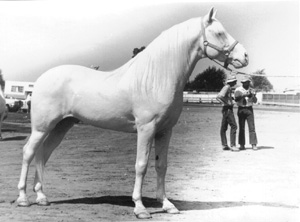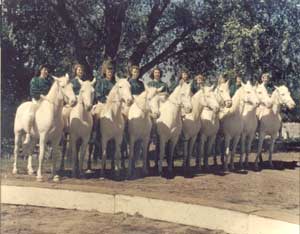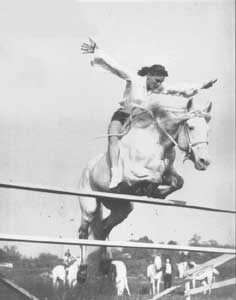American White American Creme Horse Registry

SNOWKING
1917. Crossed with their herd of predominately Morgan mares of various dark colors, King produced foals much like himself.Caleb and his wife, Ruth Hackenberg Thompson, named their new horse "American Albino" and organized a breed registry in 1936, incorporated in 1937 to register Old King's progeny.
They opened their studbook to other unrelated horses of like color. Originally incorporated as The American Albino Horse Club, the organization has used the following names:
American Albino Association, Inc.,
International American Albino Association, Inc.
and lastly, The American White Horse & Creme Horse Registry.
The Registry has moved away from the use of "albino" since, genetically, the American White Horse is not a true albino, neither is its close cousin, the American Creme Horse.
Foundation:
The American Creme Horse Registry was founded by Ruth Thompson in 1980 as a registry for cream colored horses with pink skin and along with the American White Horse Breed was a subsidiary of the International American Albino Association, Inc. Prior to that time the fore-runner of the IAAA, The American Albino Horse Club, Inc. was registering creams as off-colored whites.

The White Horse Troupe
The American White Horse
Characteristics:
The American White Horse breed is a color breed. Individuals within the breed will vary in conformation and type according to their background breeding. For example one from Arab bloodlines will differ greatly from one with draft breeding. The main requirement, thus, is its coloring. An American White must have a uniformly, true-white coat and have pink skin. Eye color will vary. White horses have been known to have the following colors of eyes: dark brown, dark blue-black, blue, very pale blue and multi-colored (sometimes called hazel). No mottling of skin such as is common to appaloosas is acceptable. Since some horses as they age will develop a few very small black spots on their skin in the areas of extremities, these are permitted.
White horses are born white and do not change color. The whiteness of their coats is comparable to a snowy white bunny rabbit...or the white areas on a pinto horse. White horses should not be confused with cream horses. White horses come from a different, dominant white gene where a cream horses come from a dilute gene. White horses will reproduce color as
follows: A white horse bred to a colored horse has 50% chance of producing a white or colored foal. A white horse bred to a white horse will produce a 75% crop of white foals. The off colored foals of a white horse can be any color with chestnuts seeming to be in the higher percentage.
The American White Horse should be bred not only for its color but for a good disposition. The breed, as a whole, is known to be of good disposition and to be intelligent and willing when properly treated and trained. The American White Horse does not go blind or deaf and is not loco, as many folks are told.American White Horses, when given proper care, live long and useful lives. Many have lived into their late Twenties and early Thirties. Being pink-skinned does require some extra precautions, however. Although they can be pastured outside, they do better if they can be in the shade during mid-day when ultra violet rays from the sun are at their strongest. It is suggested they be given protection between the hours of 10:00 a.m. and 4:00 p.m. Otherwise, they should be handled just like any other horse of color.
The American White Horse has proven to be very versatile and has been used for parades, shows, movies, driving, jumping, gymkhana competition, western and English pleasure, youth camp mount and handicapped riding programs.

The American Creme Horse
Characteristics:
The American Creme Horse must have pink skin. Its eyes can be any color but most commonly will be pale blue or a very pale amber. Creams never have truly pink or red eyes, but the iris may be such a pale blue that it appears nearly white and the pupil of the eye will reflect pink, however this is reflected lighting, not eye coloring. Its pink skin may be of a darker shade, more to the tan, but must not be gray or black. It cannot have mottling on the skin such as is common with Appaloosas. It cannot have spots such as Paints and Appaloosas have, but must have cream colored coats which may vary from off white to a fairly rich cream but lighter than palomino. The mane and tail may vary from white to cream to rich russet coloring and creams descending from buckskins or duns may have darker cream points on the legs. White markings such as blazes, stars and sox are permitted.
Cream horses vary in coloring and may be born nearly white or a rich cream which looks almost gold like a palomino. Creams may lighten to almost white as they age, or in rare cases may become a darker cream. Their skin will remain light, however.
The cream color is caused by a recessive gene meaning that a cream bred to a horse of color will dilute the color, ie. a cream bred to a bay will produce a buckskin and a cream bred to a chestnut will produce a palomino. A cream bred to another cream will produce 100 percent cream foals.
The American Cremes have proven to be of good disposition, intelligent, and perform well according to each horse's particular type. They have been used as jumpers, trail horses, gymkana competition horses, barrel racers, driving horses, ranch horses, as well as pleasure horses and show horses.
The American Creme has a normal life expectancy if given appropriate care. One must consider that the lighter skin is somewhat more sensitive to sun exposure than a dark skinned horse and it is recommended that shade be provided for mid-day sun, ie. from the hours of 10:00 a.m. to 4:00 p.m.
This time period may need to be extended for desert regions and tropical regions. Sun sensitivity varies in different individuals and usually only affects the areas where there is no hair covering, ie. end of muzzle and in some horses, area of eyelids.
The American Creme does not go blind or deaf and is not loco. Statements of some horse people differ from this but shows their lack of understanding of this unique horse. Recent research has proven their light colored hooves are just as healthy and durable as dark colored hooves.
For more information click here to email us or write to:
or click on the following buttons to print forms and mail registration to:
American White Horse Registry
or
AWACHR
90,000 Edwards Road
Naper, NE 68755
Information compiled by Carley Daugherty